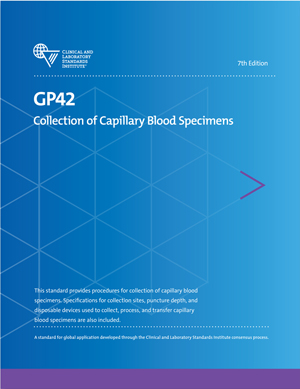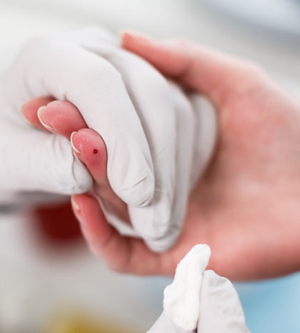New Skin Puncture Standard Packed with Changes
Your training materials and procedure manuals need updating
by Dennis Ernst • January 15, 2021

If you've not updated your training materials and procedure manual regarding capillary blood collections since October, they probably are out of date and no longer reflect the prevailing standard of care.
Many of you realize by now that CLSI released their latest revision of GP42, Collection of Capillary Blood Specimens late last year. Four years in the making, this 7th edition is probably the most comprehensive since first published in 1977. Changes include:
- Permitting fingersticks on infants between 6-12 months of age as long as the infant weighs more than 10 kg and the depth of the puncture does not exceed 1.5 mm;
- The great toe is suggested as an acceptable site;
- Completely reorganized as a Quality Management Systems document by incorporating QMS principles into its format, ensuring capillary collections are performed at a higher level of overall quality;
- Greater detail on patient and sample identification, harmonizing the document with CLSI's standard GP33, Accuracy in Patient and Sample Identification;
- An expanded section on proper puncture sites detailing sites that should and must be avoided, as well as those that require physician permission;
- Greater clarity and detail on proper patient positioning;
- Hand hygiene is required before and after patient contact and must include soap and water for visibly soiled hands and on patients infected with C. difficile;
- Completely updated references and images.
In the new standard, sites listed that should be avoided include areas that are extensively scarred, healed burns, inflamed, edematous, and previously punctured sites, earlobes and thumbs. Sites that must be avoided include infected sites and the pinky finger. Sites on the same side as a mastectomy still require physician's permission. That's nothing new, but it will be new to some now that it's more clearly articulated.
Users of the standard will appreciate the expanded section differentiating test results that vary significantly from venous blood samples. That's important because most facilities that test capillary samples still list reference ranges on the lab report that are based on venous blood, and usually without noting that the sample tested was capillary blood. Physicians who use venous blood normals for interpreting capillary blood are likely to misinterpret total protein, bilirubin, calcium, sodium, and chloride results, which are significantly lower in capillary blood. Likewise for glucose results, which are significantly higher. The plot (and capillary blood) thickens for one-day-old newborns, whose hemoglobin and hematocrit values are up to 12% higher in capillary blood.

Having chaired the committees that completed the 5th and 6th versions of this standard, my role as a member of the committee instead of chairholder afforded me the opportunity to work more closely with individual passages rather than coordinate the team's collective efforts. It was a refreshing change for me, and allowed fresh faces to step up and become more active within CLSI. Some passages were not without disagreement, however, but the leadership of the committee navigated around the issues, never failing to obtain consensus. What we have with GP42-A7 is a well-researched, highly processed document that reflects the consensus of some of the most knowledgeable, passionate and dedicated laboratory professionals on the planet. I'm personally grateful for the opportunity to serve CLSI and the global healthcare industry by participating in this important work. I think you'll find it a necessary update in your library of mission-critical publications.
Make no mistake, this is the standard by which every healthcare professional and facility will be judged should their practices come under scrutiny. As an expert witness in phlebotomy-related litigation for the last 25 years, I can attest that the CLSI standards are given the highest priority in litigation as defining the standard of care. In short, you don't want to be caught out of compliance with this, or any CLSI standard. It won't go well for you or your risk manager.
Everyone who performs, teaches or manages blood collection personnel should obtain a copy of this standard and update their training materials and procedure manuals immediately. If you haven't already done so, you'll have a hard time convincing attorneys, judges and juries (and even me) you're operating within the standard of care.
Digital or hard copies of GP42-A7 can be obtained directly from CLSI or, by special arrangement, from the Center for Phlebotomy Education on our CLSI Standards web page.
The Center for Phlebotomy Education has also developed a customizable procedure template for capillary punctures managers can download for adaptation. It includes all the provisions of the new standard and is written in laboratory-procedure format.
overall rating: my rating: log in to rate
capillary CLSI fingerstick GP42 heelstick procedure YouTube skin
